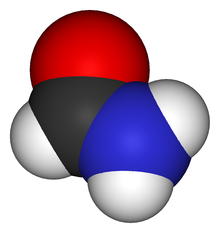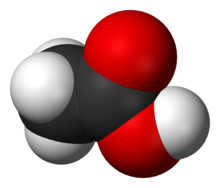- Anexo:Moléculas detectadas en el medio interestelar
-
Ésta es una lista de moléculas detectadas en el medio interestelar, agrupadas según el número de átomos constituyentes. Se reseña también su fórmula química, junto a las formas ionizadas que se han detectado.
Contenido
Detección
Todas las moléculas listadas han sido detectadas a partir de sus líneas espectrales. Dichas líneas se generan a partir de transiciones entre diferentes niveles electrónicos, o a partir de transiciones entre diferentes niveles rotacionales. La detección tiene lugar en las porciones infrarroja, microondas o de radio del espectro.[1] La primera molécula detectada fue el radical metino (·CH) en 1937.[2]
Las moléculas interestelares se forman en las nubes moleculares interestelares o circumestelares. En general se dan cuando una molécula se ioniza, normalmente cuando un rayo cósmico incide sobre ella. La molécula adquiere por lo general una carga positiva, y se ve atraída electrostáticamente por los electrones de otra molécula neutra cercana. También pueden generarse compuestos a partir de reacciones entre átomos y moléculas neutras, aunque este proceso es bastante más lento.[1] [3] El polvo desempeña un papel fundamental de proteger a las moléculas de los efectos ionizantes de la radiación ultravioleta emitida por las estrellas.[4]
Una zona particularmente rica en moléculas interestelares es Sagitario B2, una nube molecular gigante cercana al centro galáctico. Ésta nebulosa es un objetivo frecuente de los radiotelescopios. Aproximadamente la mitad de las moléculas listadas fueron encontradas por primera vez en esta nube, y la práctica totalidad de las restantes también han sido halladas aquí.[5]
Moléculas
Las siguientes tablas muestran moléculas detectadas en el medio interestelar, y se agrupan según el número de átomos que las forman. Si no hay entrada en la columna Molécula, significa que sólo se ha hallado una forma ionizada. Las moléculas que no aparecen en la literatura científica también tienen este campo en blanco.
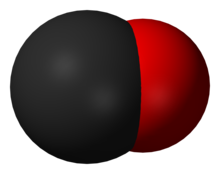 El monóxido de carbono se usa frecuentemente para determinar la distribución de masa en las nubes moleculares.[6]
El monóxido de carbono se usa frecuentemente para determinar la distribución de masa en las nubes moleculares.[6]
Tabla 1. Diatómicas Molécula Nombre Iones AlCl Monocloruro de aluminio[7] [8] — AlO Monóxido de aluminio[9] [10] [11] — AlF Monofluoruro de aluminio[12] [7] — C2 Carbono dímero[13] [14] — — Fluorometilidinio CF+[15] CH radical metino[16] CH+[17] CN radical cianógeno[18] [19] [7] [16] — CO Monóxido de carbono[7] CO+[20] CP Monofosfuro de carbono[19] — CS Monosulfuro de carbono[7] — FeO Óxido de hierro (II)[21] — H2 Hidrógeno molecular[22] — HCl Cloruro de hidrógeno[23] — HF Fluoruro de hidrógeno[24] — HN Monohidruro de nitrógeno[25] — HO radical hidroxilo[7] — KCl Cloruro de potasio[7] [8] — N2 Nitrógeno molecular[26] — NO Óxido nítrico[27] — NS Sulfuro de nitrógeno[7] — NaCl Cloruro sódico[7] [8] — O2 Oxígeno molecular[28] — PN Nitruro de fósforo[29] — SH Hidruro de azufre[30] SH+[31] SO Monóxido de azufre[7] SO+[17] SiC Carborundo[32] [7] — SiN Mononitruro de silicio[7] — SiO Monóxido de silicio[7] — SiS Monosulfuro de silicio[7] —  El hidrógeno molecular protonado es uno de los iones más abundantes del Universo. Fue detectado por primera vez en 1993.[33]
El hidrógeno molecular protonado es uno de los iones más abundantes del Universo. Fue detectado por primera vez en 1993.[33]
Tabla 2. Triatómicas Molécula Nombre Iones AlNC Isocianato de aluminio[7] — AlOH Hidróxido de aluminio[34] — C3 Tricarbono[14] — C2H Radical etinilo [7] [18] — C2O Monóxido de dicarbono[35] — C2P [36] — C2S Tioxoetilideno[37] — CO2 Dióxido de carbono[38] — — Hidrógeno molecular protonado H3+[39] H2C Metileno[40] — H2O Agua[41] — H2S Sulfuro de hidrógeno[7] — HCN Cianuro de hidrógeno[42] [7] [18] — HCO Radical formilo[43] HCO+[44] [43] [17] — Tioformilo HCS+[44] [17] HNC Isocianuro de hidrógeno[45] — — Diazenilio HN2+[44] HNO Nitroxilo[46] — — Isoformilo HOC+[18] KCN Cianuro potásico[7] — MgCN Cianuro magnésico[7] — MgNC Isocianuro de magnesio[7] — NH2 Radical amino[47] — — — N2H+[48] [17] N2O Óxido nitroso[49] — NaCN Cianuro de sodio[7] — OCS Sulfuro de carbonilo[50] — SO2 Dióxido de azufre[51] [7] c-SiC2 c-Dicarburo de silicio[7] [32] — SiCN Carbonitruro de silicio[52] — SiNC Naftocianuro de silicio[53] — 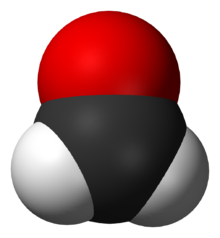 El formadelhído es una molécula orgánica ampliamente distribuida en el medio interestelar.[54]
El formadelhído es una molécula orgánica ampliamente distribuida en el medio interestelar.[54]
Tabla 3. Cuatro átomos Molécula Nombre Iones l-C3H Propinlidinio[55] [7] — c-C3H Ciclopropinlidinio[56] — C3N Cianoetinil[57] — C3O Tricarbono monoxide[55] — C3S Tricarbonosulfide[7] [37] — — Hidronio H3O+[58] C2H2 Acetileno[59] — H2CN Metileno amidógeno[60] H2CN+[17] H2CO Formaldehído[61] — H2CS Tioformaldehído[62] — HCCN —[63] — — Cianuro de hidrógeno protonado HCNH+[44] — Dióxido de carbono protonado HOCO+[64] HNCO Ácido isociánico[51] — HNCS Ácido isotiociánico[65] — NH3 Amoníaco[66] [7] — SiC3 Tricarburo de silicio[7] — 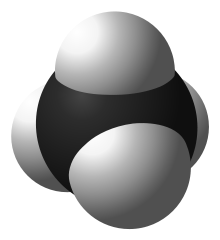 El metano, principal componente del gas natural, ha sido detectado en la cola de los cometas y en la atmósfera de algunos planetas del Sistema Solar.[67]
El metano, principal componente del gas natural, ha sido detectado en la cola de los cometas y en la atmósfera de algunos planetas del Sistema Solar.[67]
Table 4. Cinco átomos Molécula Nombre Iones C5 —[14] — CH4 Metano[68] [59] — c-C3H2 Ciclopropenilideno[69] [70] [18] — l-H2C3 Propadienilideno[70] — H2CCN Cianometilo[71] — H2C2O Ceteno[51] — H2CNH Metilenimina[72] — — Formaldehído protonado H2COH+[73] HC4 Butadinilo[7] — HC3N Cianoacetileno[74] [7] [18] [44] [70] — HCC-NC Isocianoacetileno[75] — HCOOH Ácido fórmico[70] — NH2CN Cianamida[76] — SiC4 Clúster de carburo de silicio[32] — SiH4 Silano[77] — Tabla 5. Seis átomos Molécula Designation Iones c-H2C3O Ciclopropenona[79] — C2H4 Etileno[59] — CH3CN Acetonitrilo[80] [51] — CH3NC Isocianato de metilo[80] — CH3OH Metanol[51] — CH3SH Metanotiol[81] — l-H2C4 —[82] [7] — — Cianoacetileno protonado HC3NH+[44] HCONH2 Formamida[78] — HC5 Pentinilidina[7] [37] — HC2CHO Propinal[83] — HC4N —[7] — CH2CNH Cetenimina[69] — 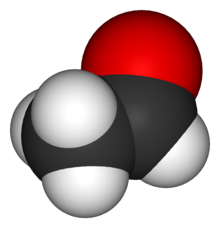 El acetaldehído (arriba) y sus isómeros alcohol vinílico y óxido de etileno han sido detectados en el espacio interestelar.[84]
El acetaldehído (arriba) y sus isómeros alcohol vinílico y óxido de etileno han sido detectados en el espacio interestelar.[84]
Tabla 6. Siete átomos Molécula Nombre Iones c-C2H4O Óxido de etileno[85] — CH3C2H Metilacetileno[18] — H3CNH2 Metilamina[86] — CH2CHCN Acrilonitrilo[51] [80] — H2CHCOH Alcohol vinílico[84] — C6H Hexatriinil[7] [37] C6H-[87] [70] HC4CN Cianodiacetileno[51] [80] [74] — CH3CHO Acetaldehído[7] [85] — Tabla 7. Ocho átomos Molécula Nombre H3CC2CN Metilcianoacetileno[88] H2COHCHO Glicolaldehído[89] CH3OOCH Formiato de metilo[89] [51] [70] CH3COOH Ácido acético[89] H2C6 Hexapentaenilideno[7] [82] CH2CHCHO Propenal[69] CH2CCHCN Cianoaleno[88] [69] HC7 —[7] Tabla 8. Nueve átomos Molécula Nombre CH3C4H Metildiacetileno[91] CH3OCH3 Dimetiléter[92] CH3CH2CN Propionitrilo[7] [51] [80] [70] CH3CONH2 Acetamida[78] [69] CH3CH2OH Alcohol trans-etílico[93] HC8 —[7] HC6CN Cianohexatriíno[94] HC7N Cianotriacetileno[7] [66] [95] Tabla 9. Diez o más átomos Atoms Molécula Nombre 10 (CH3)2CO Acetona[96] [51] 10 CH3CH2CHO Propanal[69] 10 CH3C5N Metilcianodiacetileno[69] 11 HC8CN Cianotretraacetileno[7] [95] 11 CH3C6H Metiltriacetileno[91] [69] 11 H3COC2H5 trans-etil metiléter[97] 12 CH3OC2H5 Trans-etil metiléter[98] 12 H6C6 Benceno[82] 13 HC10CN Cianodecapentaína[95] Moléculas deuteradas
Tabla 10. Moléculas que contienen un átomo de deuterio Molécula Designation HD, H2D+ Hidrógeno molecular deuterado[99] [100] HDO Agua[101] DCN Cianuro de hidrógeno[102] DCO Radical formilo[102] DNC Isocianuro de hidrógeno[102] N2D+ —[102] NHD2, ND3 Amoniaco[100] [103] HDCO, D2CO Formaldehído[104] [100] CH2DCCH, CH3CCD Metilacetileno[105] [106] Moléculas no confirmadas
Se ha informado de la detección de las siguientes moléculas, aunque dicha observación no ha sido confirmada.
Tabla 11. Moléculas no confirmadas Molécula Nombre H2NH2CCOOH Glicina[107] CO(CH2OH)2 1,3-dihidroxipropanona[108] Véase también
- Astroquímica
- Química
- Fórmula química
- Banda interestelar difusa
- Mecanismo prohibido
Enlaces externos
- Woon, David E. (1 de Febrero, 2007). «Interstellar and circumstellar molecules». The Astrochemist. Consultado el 13-02-2007.
- Hudson, Reggie (1 de Febrero, 2007). «Interstellar Molecules». NASA's Cosmic Ice Lab. Consultado el 13-02-2007.
- Wootten, Al (Noviembre, 2005). «The 129 reported interstellar and circumstellar molecules». National Radio Astronomy Observatory. Consultado el 13-02-2007.
- F. J. Lovas, R. A. Dragoset (February, 2004). «NIST Recommended Rest Frequencies for Observed Interstellar Molecular Microwave Transitions, 2002 Revision». National Institute of Standards and Technology. Consultado el 13-02-2007.
Referencias
- ↑ a b Nummelin, Albert (13-07-2006). «Observations of interstellar molecules». Chalmers University of Technology. Consultado el 06-02-2007.
- ↑ Woon, D. E. (May, 2005). «Methylidyne radical». The Astrochemist. Consultado el 13-02-2007.
- ↑ Dalgarno, A. (2006). «Interstellar Chemistry Special Feature: The galactic cosmic ray ionization rate». Proceedings of the National Academy of Science 103 (33): pp. 12269–12273. doi:. PMID 16894166. http://www.pubmedcentral.nih.gov/articlerender.fcgi?artid=1567869.
- ↑ Brown, Laurie M.; Pais, Abraham; Pippard, A. B. (1995). «The physics of the interstellar medium». Twentieth Century Physics (2nd edición). CRC Press. p. 1765. ISBN 0750303107.
- ↑ S. E. Cummins, R. A. Linke, P. Thaddeus (1986). «A survey of the millimeter-wave spectrum of Sagittarius B2». Astrophysical Journal Supplement Series 60: pp. 819-878. http://adsabs.harvard.edu/abs/1986ApJS...60..819C.
- ↑ «The Structure of Molecular Cloud Cores». Centre for Astrophysics and Planetary Science, University of Kent. Consultado el 16-02-2007.
- ↑ a b c d e f g h i j k l m n ñ o p q r s t u v w x y z aa ab ac ad ae af ag ah ai aj ak al am an Ziurys, Lucy M. (2006). «The chemistry in circumstellar envelopes of evolved stars: Following the origin of the elements to the origin of life». Proceedings of the National Academy of Sciences 103 (33): pp. 12274-12279. http://www.pnas.org/cgi/content/full/103/33/12274.
- ↑ a b c J. Cernicharo, M. Guelin (1987). «Metals in IRC+10216 - Detection of NaCl, AlCl, and KCl, and tentative detection of AlF». Astronomy and Astrophysics 183 (1): pp. L10-L12. http://adsabs.harvard.edu/abs/1987A&A...183L..10C.
- ↑ D. C. Tyte (1964). «Red (B2Π–A2σ) Band System of Aluminium Monoxide». Nature 202: p. 383. doi:.
- ↑ D. C. Tyte (1967). «The dissociation energy of aluminium monoxide"». Proc. Phys. Soc. 92: p. 1134. doi:.
- ↑ Johnson E. R. & Low C. H. (1967). «Further spectral observations of grenade glow clouds in the lower thermosphere». Australian Journal of Physics 20: p. 577. http://adsabs.harvard.edu/full/1967AuJPh..20..577J.
- ↑ L. M. Ziurys, A. J. Apponi, T. G. Phillips (1994). «Exotic fluoride molecules in IRC +10216: Confirmation of AlF and searches for MgF and CaF». Astrophysical Journal 433 (2): pp. 729-732. http://adsabs.harvard.edu/abs/1994ApJ...433..729Z.
- ↑ D. L. Lambert, Y. Sheffer, S. R. Federman (1995). «Hubble Space Telescope observations of C2 molecules in diffuse interstellar clouds». Astrophysical Journal 438: pp. 740-749. http://adsabs.harvard.edu/abs/1995ApJ...438..740L.
- ↑ a b c G. A. Galazutdinov, F. A. Musaev, J. Krelowski (2001). «On the detection of the linear C5 molecule in the interstellar medium». Monthly Notices of the Royal Astronomical Society 325: pp. 1332-1334. http://adsabs.harvard.edu/abs/2001MNRAS.325.1332G.
- ↑ D. A. Neufeld, P. Schilke, K. M. Menten, M. G. Wolfire, J. H. Black, F. Schuller, H. S. P. Müller, S. Thorwirth, R. Güsten, S. Philipp (2006). «Discovery of interstellar CF+». Astronomy and Astrophysics 454 (2): pp. L37-L40. http://adsabs.harvard.edu/abs/2006astro.ph..3201N.
- ↑ a b Adams, Walter S. (1941). «Some Results with the COUDÉ Spectrograph of the Mount Wilson Observatory». Astrophysical Journal 93: pp. 11-23. http://adsabs.harvard.edu/abs/1941ApJ....93...11A.
- ↑ a b c d e f Smith, D. (1988). «Formation and Destruction of Molecular Ions in Interstellar Clouds». Philosophical Transactions of the Royal Society of London 324 (1578): pp. 257-273. http://adsabs.harvard.edu/abs/1988RSPTA.324..257S.
- ↑ a b c d e f g A. Fuente, S. García-Burillo, M. Gerin, D. Teyssier, A. Usero, J. R. Rizzo, P. de Vicente (2005). «Photon-dominated Chemistry in the Nucleus of M82: Widespread HOC+ Emission in the Inner 650 Parsec Disk». Astrophysical Journal 619 (2): pp. L155-L158. http://adsabs.harvard.edu/abs/2005ApJ...619L.155F.
- ↑ a b M. Guelin, J. Cernicharo, G. Paubert, B. E. Turner (1990). «Free CP in IRC + 10216». Astronomy and Astrophysics 230: pp. L9-L11. http://adsabs.harvard.edu/abs/1990A&A...230L...9G.
- ↑ W. B. Latter, C. K. Walker, P. R. Maloney (1993). «Detection of the Carbon Monoxide Ion (CO +) in the Interstellar Medium and a Planetary Nebula». Astrophysical Journal Letters 419: pp. L97. http://adsabs.harvard.edu/abs/1993ApJ...419L..97L.
- ↑ R. S. Furuya, C. M. Walmsley, K. Nakanishi, P. Schilke, R. Bachiller (2003). «Interferometric observations of FeO towards Sagittarius B2». Astronomy and Astrophysics 409: pp. L21-L24. http://adsabs.harvard.edu/abs/2003A&A...409L..21F.
- ↑ Adams, Walter S. (1970). «Rocket Observation of Interstellar Molecular Hydrogen». Astrophysical Journal 161: pp. L81-L85. http://adsabs.harvard.edu/abs/1970ApJ...161L..81C.
- ↑ G. A. Blake, J. Keene, T. G. Phillips (1985). «Chlorine in dense interstellar clouds - The abundance of HCl in OMC-1». Astrophysical Journal, Part 1 295: pp. 501-506. http://adsabs.harvard.edu/abs/1985ApJ...295..501B.
- ↑ D. A. Neufeld, J. Zmuidzinas, P. Schilke, T. G. Phillips (1997). «Discovery of Interstellar Hydrogen Fluoride». Astrophysical Journal 488 (2): pp. L141–L144. http://www.journals.uchicago.edu/cgi-bin/resolve?id=doi:10.1086/310942.
- ↑ D. M. Meyer, K. C. Roth (1991). «Discovery of interstellar NH». Astrophysical Journal, Part 2 - Letters 376: pp. L49-L52. http://adsabs.harvard.edu/abs/1991ApJ...376L..49M.
- ↑ Astronomers Detect Molecular Nitrogen Outside our Solar System for the First Time. Goddard Space Flight Center. 9 de junio de 2004. http://www.gsfc.nasa.gov/news-release/releases/2004/04-024.htm. Consultado el 20-12-2006.
- ↑ D. McGonagle, W. M. Irvine, Y. C. Minh, L. M. Ziurys (1990). «Detection of nitric oxide in the dark cloud L134N». Astrophysical Journal, Part 1 359: pp. 121-124. http://adsabs.harvard.edu/abs/1990ApJ...359..121M.
- ↑ «Nucleosynthesis and Galactic Chemical Evolution of the Isotopes of Oxygen». Proceedings of the NASA Cosmochemistry Program and the Lunar and Planetary Institute. Workgroup on Oxygen in the Earliest Solar System. 9022. http://www.lpi.usra.edu/meetings/ess2005/pdf/9022.pdf.
- ↑ Ziurys, L. M. (1987). «Detection of interstellar PN - The first phosphorus-bearing species observed in molecular clouds». Astrophysical Journal, Part 2 - Letters to the Editor 321: pp. L81-L85. http://adsabs.harvard.edu/abs/1987ApJ...321L..81Z.
- ↑ T. J. Millar, N. G. Adams, D. Smith, W. Lindinger, H. Villinger (1986). «Identification of SH v=1 Ro-vibrational Lines in R Andromedae». Monthly Notices of the Royal Astronomical Society 221: pp. 673-678. http://adsabs.harvard.edu/abs/1986MNRAS.221..673M.
- ↑ T. J. Millar, N. G. Adams, D. Smith, W. Lindinger, H. Villinger (1986). «The chemistry of SH(+) in shocked interstellar gas». Monthly Notices of the Royal Astronomical Society 221: pp. 673-678. http://adsabs.harvard.edu/abs/1986MNRAS.221..673M.
- ↑ a b c G. Pascoli, M. Comeau (1995). «Silicon Carbide in Circumstellar Environment». Astrophysics and Space Science 226: pp. -149-163. http://adsabs.harvard.edu/abs/1995Ap&SS.226..149P.
- ↑ Oka, Takeshi (2006). «Interstellar H3+». Procedings of the National Academy of Science 103 (33): pp. 12235-12242. http://www.pnas.org/cgi/content/full/103/33/12235?ck=nck.
- ↑ Tenenbaum, E. D.; Ziurys, L. M.. "Exotic Metal Molecules in Oxygen-rich Envelopes: Detection of AlOH (X1Σ+) in VY Canis Majoris". Astrophysical Journal 712: L93–L97.
- ↑ M. Ohishi, S.-I. Ishikawa, C. Yamada, H. Kanamori, W. M. Irvine, R. D. Brown, P. D. Godfrey, N. Kaifu, H. Suzuki (1991). «Detection of a new carbon-chain molecule, CCO». Astrophysical Journal, Part 2 - Letters 380: pp. L39-L42. http://adsabs.harvard.edu/abs/1991ApJ...380L..39O.
- ↑ Halfen, D. T.; Clouthier, D. J.; Ziurys, L. M. (2008). "Detection of the CCP Radical (X 2Πr) in IRC +10216: A New Interstellar Phosphorus-containing Species". Astrophysical Journal 677: L101–L104. doi:10.1086/588024
- ↑ a b c d W. M. Irvine, L. M. Ziurys, L. W. Avery, H. E. Matthews, P. Friberg (1988). «Newly detected molecules in dense interstellar clouds». Astrophysical Letters and Communications 26: pp. 167-180. http://adsabs.harvard.edu/abs/1988ApL&C..26..167I.
- ↑ D. C. B. Whittet, H. J. Walker (1991). «On the occurrence of carbon dioxide in interstellar grain mantles and ion-molecule chemistry». Monthly Notices of the Royal Astronomical Society 252: pp. 63-67. http://adsabs.harvard.edu/abs/1991MNRAS.252...63W.
- ↑ Oka, Takeshi (2006). «Interstellar H3+». Proceedings of the National Academy of Sciences 103 (33): pp. 12235-12242. http://www.pnas.org/cgi/content/full/103/33/12235?ck=nck.
- ↑ J. M. Hollis, P. R. Jewell, F. J. Lovas (1995). «Confirmation of interstellar methylene». Astrophysical Journal, Part 1 438: pp. 259-264. http://adsabs.harvard.edu/abs/1995ApJ...438..259H.
- ↑ «Europes space telescope ISO finds water in distant places». ESO (April 29, 1997). Consultado el 08-02-2007.
- ↑ L. E. Snyder, D. Buhl (1971). «First Detection of Vibrationally Excited HNC in Space». Astrophysical Journal 163: pp. L47-L52. http://adsabs.harvard.edu/abs/1971ApJ...163L..47S.
- ↑ a b M. S. Schenewerk, L. E. Snyder, A. Hjalmarson (1986). «Interstellar HCO - Detection of the missing 3 millimeter quartet». Astrophysical Journal, Part 2 - Letters to the Editor 303: pp. L71-L74. http://adsabs.harvard.edu/abs/1986ApJ...303L..71S.
- ↑ a b c d e f K. Kawaguchi, Y. Kasai, S.-I. Ishikawa, M. Ohishi, N. Kaifu, T. Amano (1994). «Detection of a new molecular ion HC3NH(+) in TMC-1». Astrophysical Journal 420: pp. L95. http://adsabs.harvard.edu/cgi-bin/bib_query?1994ApJ...420L..95K.
- ↑ P. Schilke, C. Comito, S. Thorwirth (2003). «First Detection of Vibrationally Excited HNC in Space». The Astrophysical Journal 582: pp. L101–L104. http://www.journals.uchicago.edu/cgi-bin/resolve?id=doi:10.1086/367628.
- ↑ «Interstellar HNO: Confirming the Identification». Atoms, ions and molecules: New results in spectral line astrophysics.
- ↑ E.F. van Dishoeck, D.J. Jansen, P. Schilke, T. G. Phillips (1993). «Detection of the Interstellar NH 2 Radical». Astrophysical Journal, Part 2 - Letters 416: pp. L83-L86. http://adsabs.harvard.edu/cgi-bin/nph-bib_query?bibcode=1993ApJ...416L..83V.
- ↑ M. Womack, L. M. Ziurys, S. Wyckoff (1992). «A survey of N2H(+) in dense clouds - Implications for interstellar nitrogen and ion-molecule chemistry». Astrophysical Journal, Part 1 387: pp. 417-429. http://adsabs.harvard.edu/abs/1992ApJ...387..417W.
- ↑ L. M. Ziurys, A. J. Apponi, J. M. Hollis, L. E. Snyder (1994). «Detection of interstellar N2O: A new molecule containing an N-O bond». Astrophysical Journal, Part 2 - Letters 436: pp. L181-L184. http://adsabs.harvard.edu/abs/1994ApJ...436L.181Z.
- ↑ P. F. Goldsmith, R. A. Linke (1981). «A study of interstellar carbonyl sulfide». Astrophysical Journal, Part 1 245: pp. 482-494. http://adsabs.harvard.edu/abs/1981ApJ...245..482G.
- ↑ a b c d e f g h i j L. E. B. Johansson, C. Andersson, J. Ellder, P. Friberg, A. Hjalmarson, B. Hoglund, W. M. Irvine, H. Olofsson, G. Rydbeck (1984). «Spectral scan of Orion A and IRC+10216 from 72 to 91 GHz». Astronomy and Astrophysics 130 (2): pp. 227-256. http://adsabs.harvard.edu/abs/1984A&A...130..227J.
- ↑ M. Guélin, S. Muller, J. Cernicharo, A. J. Apponi, M. C. McCarthy, C. A. Gottlieb, P. Thaddeus (2004). «Astronomical detection of the free radical SiCN». Astronomy and Astrophysics 363: pp. L9-L12. http://adsabs.harvard.edu/abs/2000A&A...363L...9G.
- ↑ M. Guélin, S. Muller, J. Cernicharo, M. C. McCarthy, P. Thaddeus (2004). «Detection of the SiNC radical in IRC+10216». Astronomy and Astrophysics 426: pp. L49-L52. http://adsabs.harvard.edu/abs/2004A&A...426L..49G.
- ↑ L. E. Snyder, D. Buhl, B. Zuckerman, P. Palmer (1999). «Microwave Detection of Interstellar Formaldehyde». Physical Review Letters 61 (2): pp. 77-115. http://adsabs.harvard.edu/abs/1969PhRvL..22..679S.
- ↑ a b W. M. Irvine, P. Friberg, Å. Hjalmarson, L. E. B. Johansson, P. Thaddeus, R. D. Brown, P. D. Godfrey (1984). «Confirmation of the Existence of Two New Interstellar Moléculas: C3H and C3O». Bulletin of the American Astronomical Society 16: pp. 877. http://adsabs.harvard.edu/abs/1984BAAS...16..877I.
- ↑ J. G. Mangum, A. Wootten (1990). «Observations of the cyclic C3H radical in the interstellar medium». Astronomy and Astrophysics 239: pp. 319-325. http://adsabs.harvard.edu/abs/1990A&A...239..319M.
- ↑ M. B. Bell, H. E. Matthews (1995). «Detection of C3N in the spiral arm gas clouds in the direction of Cassiopeia A». Astrophysical Journal, Part 1 438: pp. 223-225. http://adsabs.harvard.edu/abs/1995ApJ...438..223B.
- ↑ A. Wootten, B. E. Turner, J. G. Mangum, M. Bogey, F. Boulanger, F. Combes, P. J. Encrenaz, M. Gerin (1991). «Detection of interstellar H3O(+) - A confirming line». Astrophysical Journal, Part 2 - Letters 380: pp. L79-L83. http://adsabs.harvard.edu/cgi-bin/nph-bib_query?bibcode=1991ApJ...380L..79W.
- ↑ a b c Betz, A. L. (1981). «Ethylene in IRC +10216». Astrophysical Journal, Part 2 - Letters to the Editor 244: pp. -L105. http://adsabs.harvard.edu/abs/1981ApJ...244L.103B.
- ↑ M. Ohishi, D. McGonagle, W.M. Irvine, S. Yamamoto, S. Saito (1994). «Detection of a new interstellar molecule, H2CN». Astrophysical Journal, Part 2 - Letters 427: pp. L51-L54. http://adsabs.harvard.edu/abs/1994ApJ...427L..51O.
- ↑ S. Aiello, L. Morbidelli, L. Ulivi (1981). «Far UV radiation transfer and H2CO lifetime in dense interstellar clouds». Astrophysics and Space Science 80: pp. 173-187. http://adsabs.harvard.edu/abs/1981Ap&SS..80..173A.
- ↑ Y. C. Minh, W. M. Irvine, M. K. Brewer (1991). «H2CS abundances and ortho-to-para ratios in interstellar clouds». Astronomy and Astrophysics 244: pp. 181-189. http://adsabs.harvard.edu/abs/1991A&A...244..181M.
- ↑ M. Guelin, J. Cernicharo (1991). «Astronomical detection of the HCCN radical - Toward a new family of carbon-chain molecules?». Astronomy and Astrophysics 244: pp. L21-L24. http://adsabs.harvard.edu/abs/1991A&A...244L..21G.
- ↑ Y. C. Minh, W. M. Irvine, L. M. Ziurys (1988). «Observations of interstellar HOCO(+) - Abundance enhancements toward the Galactic center». Astrophysical Journal, Part 1 334: pp. 175-181. http://adsabs.harvard.edu/abs/1988ApJ...334..175M.
- ↑ M. A. Frerking, R. A. Linke, P. Thaddeus (1979). «Interstellar isothiocyanic acid». Astrophysical Journal, Part 2 - Letters to the Editor 234: pp. L143-L145. http://adsabs.harvard.edu/abs/1979ApJ...234L.143F.
- ↑ a b Nguyen-Q-Rieu, D. Graham, V. Bujarrabal (1984). «Ammonia and cyanotriacetylene in the envelopes of CRL 2688 and IRC + 10216». Astronomy and Astrophysics 138 (1): pp. L5-L8. http://adsabs.harvard.edu/abs/1984A&A...138L...5N.
- ↑ A. L. Butterworth,O. Aballain, J. Chappellaz, M. A. Sephton (2004). «Combined element (H and C) stable isotope ratios of methane in carbonaceous chondrites». Monthly Notices of the Royal Astronomical Society 347 (3): pp. 807-812. http://adsabs.harvard.edu/abs/2004MNRAS.347..807B.
- ↑ J. H. Lacy, J. S. Carr, N. J. Evans, II, F. Baas, J. M. Achtermann, J. F. Arens (1991). «Discovery of interstellar methane - Observations of gaseous and solid CH4 absorption toward young stars in molecular clouds». Astrophysical Journal 376: pp. 556-560. http://adsabs.harvard.edu/abs/1991ApJ...376..556L.
- ↑ a b c d e f g h Finley, Dave (August 7, 2006). «Researchers Use NRAO Telescope to Study Formation Of Chemical Precursors to Life». National Radio Astronomy Observatory. Consultado el 10-08-2006.
- ↑ a b c d e f g D. Fossé, J. Cernicharo, M. Gerin, P. Cox (2001). «Molecular Carbon Chains and Rings in TMC-1». Astrophysical Journal 552: pp. 168–174. http://www.journals.uchicago.edu/cgi-bin/resolve?id=doi:10.1086/320471.
- ↑ W. M. Irvine, P. Friberg, A. Hjalmarson, S. Ishikawa, N. Kaifu, K. Kawaguchi, S. C. Madden, H. E. Matthews, M. Ohishi, S. Saito, H. Suzuki, P. Thaddeus, B. E. Turner, S. Yamamoto, L. M. Ziurys (1988). «Identification of the interstellar cyanomethyl radical (CH2CN) in the molecular clouds TMC-1 and Sagittarius B2». Astrophysical Journal, Part 2 - Letters 334: pp. L107-L111. http://adsabs.harvard.edu/abs/1988ApJ...334L.107I.
- ↑ J. E. Dickens, W. M. Irvine, C. H. De Vries, M. Ohishi (1997). «Hydrogenation of Interstellar Moléculas: A Survey for Methylenimine (CH 2NH)». Astrophysical Journal 479: pp. 307. http://adsabs.harvard.edu/abs/1997ApJ...479..307D.
- ↑ M. Ohishi, S.-I. Ishikawa, T. Amano, H. Oka, W.M. Irvine, J. E. Dickens, L. M. Ziurys, A. J. Apponi (1996). «Detection of a New Interstellar Molecular Ion, H 2COH + (Protonated Formaldehyde)». Astrophysical Journal 471: pp. L61. http://adsabs.harvard.edu/abs/1996ApJ...471L..61O.
- ↑ a b C. M. Walmsley, G. Winnewisser, F. Toelle (1990). «Cyanoacetylene and cyanodiacetylene in interstellar clouds». Astronomy and Astrophysics 81 (1-2): pp. 245-250. http://adsabs.harvard.edu/abs/1980A&A....81..245W.
- ↑ K. Kawaguchi, M. Ohishi,S.-I. Ishikawa, N. Kaifu (1992). «Detection of isocyanoacetylene HCCNC in TMC-1». Astrophysical Journal 386 (2): pp. L51-L53. http://adsabs.harvard.edu/abs/1992ApJ...386L..51K.
- ↑ B. E. Turner, H. S. Liszt, N. Kaifu, A. G. Kisliakov (1975). «Microwave detection of interstellar cyanamide». Astrophysical Journal 201: pp. L149-L152. http://adsabs.harvard.edu/cgi-bin/nph-bib_query?bibcode=1975ApJ...201L.149T.
- ↑ D. M. Goldhaber, A. L. Betz (1984). «Silane in IRC +10216». Astrophysical Journal, Part 2 - Letters to the Editor 279: pp. -L55-L58. http://adsabs.harvard.edu/abs/1984ApJ...279L..55G.
- ↑ a b c J. M. Hollis, F. J. Lovas, A. J. Remijan, P. R. Jewell, V. V. Ilyushin, ;I. Kleiner (2006). «Detection of Acetamide (CH3CONH2): The Largest Interstellar Molecule with a Peptide Bond». Astrophysical Journal 643 (1): pp. L25-L28. http://adsabs.harvard.edu/abs/2006ApJ...643L..25H.
- ↑ J. M. Hollis, A. J. Remijan, P. R. Jewell, F. J. Lovas (2006). «Cyclopropenone (c-H2C3O): A New Interstellar Ring Molécula». Astrophysical Journal 642: pp. 933-939. http://adsabs.harvard.edu/abs/2006ApJ...642..933H.
- ↑ a b c d e A. J. Remijan, J. M. Hollis, F. J. Lovas, D. F. Plusquellic, P. R. Jewell (2005). «Interstellar Isomers: The Importance of Bonding Energy Differences». Astrophysical Journal 632: pp. 333–339. http://adsabs.harvard.edu/abs/1979ApJ...234L.139L.
- ↑ D. L. Lambert, Y. Sheffer, S. R. Federman (1979). «Interstellar methyl mercaptan». Astrophysical Journal, Part 2 - Letters to the Editor 234: pp. L139-L142. http://adsabs.harvard.edu/abs/1979ApJ...234L.139L.
- ↑ a b c J. Cernicharo, A. M. Heras, A. G. G. M. Tielens, J. R. Pardo, F. Herpin, M. Guélin, L. B. F. M. Waters (1997). «Infrared Space Observatory's Discovery of C4H2, C6H2, and Benzene in CRL 618». Astrophysical Journal 546 (2): pp. L123–L126. http://www.journals.uchicago.edu/cgi-bin/resolve?id=doi:10.1086/318871.
- ↑ W. M. Irvine, R. D. Brown, D. M. Cragg, P. Friberg, P. D. Godfrey, N. Kaifu, H. E. Matthews, M. Ohishi, H. Suzuki, H. Takeo (1988). «A new interstellar polyatomic molecule - Detection of propynal in the cold cloud TMC-1». Astrophysical Journal, Part 2 - Letters 335: pp. L89-L93. http://adsabs.harvard.edu/abs/1988ApJ...335L..89I.
- ↑ a b Scientists Toast the Discovery of Vinyl Alcohol in Interstellar Space. National Radio Astronomy Observatory. 1 de octubre de 2001. http://www.nrao.edu/pr/2001/vinylalco/. Consultado el 20-12-2006.
- ↑ a b J. E. Dickens, W. M. Irvine, M. Ohishi, M. Ikeda, S. Ishikawa, A. Nummelin, A. Hjalmarson (1997). «A New Interstellar Cyclic Molécula, Ethylene Oxide». Bulletin of the American Astronomical Society 29: pp. 1245. http://www.journals.uchicago.edu/cgi-bin/resolve?id=doi:10.1086/304821.
- ↑ N. Kaifu, K. Takagi, T. Kojima (1975). «Excitation of interstellar methylamine». Astrophysical Journal 198: pp. L85-L88. http://adsabs.harvard.edu/abs/1975ApJ...198L..85K.
- ↑ M. C. McCarthy, C. A. Gottlieb, H. Gupta, P. Thaddeus (2006). «Laboratory and Astronomical Identification of the Negative Molecular Ion C6H-». Astrophysical Journal 652 (2): pp. L141-L144. http://adsabs.harvard.edu/abs/2006ApJ...652L.141M.
- ↑ a b F. J. Lovas, Anthony J. Remijan, J. M. Hollis, P. R. Jewell, L. E. Snyder (2006). «Hyperfine Structure Identification of Interstellar Cyanoallene toward TMC-1». Astrophysical Journal 637 (2): pp. L37–L40. http://www.journals.uchicago.edu/cgi-bin/resolve?id=doi:10.1086/500431.
- ↑ a b c Sincell, Mark (June 27, 2006). «The Sweet Signal of Sugar in Space». American Association for the Advancement of Science. Consultado el 20-12-2006.
- ↑ D. M. Mehringer, L. E. Snyder, Y. Miao, F. J. Lovas (1997). «Detection and Confirmation of Interstellar Acetic Acid». Astrophysical Journal Letters 480: pp. L71. http://adsabs.harvard.edu/cgi-bin/nph-bib_query?bibcode=1997ApJ...480L..71M.
- ↑ a b A. J. Remijan, J. M. Hollis, L. E. Snyder, P. R. Jewell, F. J. Lovas (2006). «Methyltriacetylene (CH3C6H) toward TMC-1: The Largest Detected Symmetric Top». Astrophysical Journal 643 (1): pp. L37-L40. http://adsabs.harvard.edu/abs/2006ApJ...643L..37R.
- ↑ Z. Peeters, S. D. Rodgers, S. B. Charnley, L. Schriver-Mazzuoli, A. Schriver, J. V. Keane, P. Ehrenfreund (2006). «Astrochemistry of dimethyl ether». Astronomy and Astrophysics 445 (1): pp. 197-204. http://adsabs.harvard.edu/abs/2006A&A...445..197P.
- ↑ B. Zuckerman, B. E. Turner, D. R. Johnson, F. J. Lovas, N. Fourikis, P. Palmer, M. Morris, A. E. Lilley, J. A. Ball, F. O. Clark (1975). «Detection of interstellar trans-ethyl alcohol». Astrophysical Journal 196 (2): pp. L99-L102. http://adsabs.harvard.edu/abs/1975ApJ...196L..99Z.
- ↑ H. W. Kroto, C. Kirby, D. R. M. Walton, L. W. Avery, N. W. Broten, J. M. MacLeod, T. Oka (2002). «The detection of cyanohexatriyne in Heiles's cloud 2». The Astrophysical Journal 219: pp. L133-L137. http://adsabs.harvard.edu/abs/1978ApJ...219L.133K.
- ↑ a b c M. B. Bell, P. A. Feldman, M. J. Travers, M. C. McCarthy, C. A. Gottlieb, P. Thaddeus (1997). «Detection of HC11N in the Cold Dust Cloud TMC-1». Astrophysical Journal 483 (2): pp. L61–L64. http://www.journals.uchicago.edu/cgi-bin/resolve?id=doi:10.1086/310732.
- ↑ L. E. Snyder, F. J. Lovas, D. M. Mehringer, N. Y. Miao, Y.-J. Kuan, J. M. Hollis, P. R. Jewell (2002). «Confirmation of Interstellar Acetone». The Astrophysical Journal 578 (1): pp. 245–255. http://www.journals.uchicago.edu/cgi-bin/resolve?id=doi:10.1086/342273.
- ↑ G. W. Fuchs, U. Fuchs, T. F. Giesen, F. Wyrowski (2005). «Trans-ethyl methyl ether in space. A new look at a complex molecule in selected hot core regions». Astronomy and Astrophysics 444 (2): pp. 521-530. http://adsabs.harvard.edu/abs/2005astro.ph..8395F.
- ↑ G. W. Fuchs, U. Fuchs, T. F. Giesen, F. Wyrowski (2005). «Trans-ethyl methyl ether in space. A new look at a complex molecule in selected hot core regions». Astronomy and Astrophysics 444 (2): pp. 521-530. http://adsabs.harvard.edu/abs/2005astro.ph..8395F.
- ↑ S. Lacour, M. K. André, P. Sonnentrucker, F. Le Petit, D. E. Welty, J.-M. Desert, R. Ferlet, E. Roueff, D. G. York (2005). «Deuterated molecular hydrogen in the Galactic ISM. New observations along seven translucent sightlines». Astronomy and Astrophysics 430: pp. 967-977. http://adsabs.harvard.edu/abs/2005A&A...430..967L.
- ↑ a b c Ceccarelli, Cecilia (2002). «Millimeter and infrared observations of deuterated molecules». Planetary and Space Science 50 (12-13): pp. 1267-1273. http://adsabs.harvard.edu/abs/2002P&SS...50.1267C.
- ↑ Green, Sheldon (1989). «Collisional excitation of interstellar molecules - Deuterated water, HDO». Astrophysical Journal Supplement Series 70: pp. 813-831. http://adsabs.harvard.edu/abs/1989ApJS...70..813G.
- ↑ a b c d B. E. Turner, B. Zuckerman (1978). «Observations of strongly deuterated molecules - Implications for interstellar chemistry». Astrophysical Journal, Part 2 - Letters to the Editor 225: pp. L75-L79. http://adsabs.harvard.edu/abs/1978ApJ...225L..75T.
- ↑ D. C. Lis, E. Roueff, M. Gerin, T. G. Phillips, L. H. Coudert, F. F. S. van der Tak, P. Schilke (/2002). «Detection of Triply Deuterated Ammonia in the Barnard 1 Cloud». Astrophysical Journal 571 (1): pp. L55-L58. http://adsabs.harvard.edu/abs/2002ApJ...571L..55L.
- ↑ Turner, B. E. (1990). «Detection of doubly deuterated interstellar formaldehyde (D2CO) - an indicator of active grain surface chemistry». Astrophysical Journal, Part 2 - Letters 362: pp. L29-L33. http://adsabs.harvard.edu/abs/1990ApJ...362L..29T.
- ↑ M. Gerin, F. Combes, G. Wlodarczak, P. Encrenaz, C. Laurent (1992). «Interstellar detection of deuterated methyl acetylene». Astronomy and Astrophysics 253 (2): pp. L29-L32. http://adsabs.harvard.edu/abs/1992A&A...253L..29G.
- ↑ A. J. Markwick, S. B. Charnley, H. M. Butner, T. J. Millar (2005). «Interstellar CH3CCD». The Astrophysical Journal 627 (2): pp. L117-L120. http://adsabs.harvard.edu/abs/2005ApJ...627L.117M.
- ↑ L. E. Snyder, F. J. Lovas, J. M. Hollis, D. N. Friedel, P. R. Jewell, A. Remijan, V. V. Ilyushin, E. A. Alekseev, S. F. Dyubko (2005). «A Rigorous Attempt to Verify Interstellar Glycine». Astrophysical Journal 619 (2): pp. 914-930. http://adsabs.harvard.edu/abs/2004astro.ph.10335S.
- ↑ S. L. Widicus Weaver, G. A. Blake (2005). «1,3-Dihydroxyacetone in Sagittarius B2(N-LMH): The First Interstellar Ketose». Astrophysical Journal 624 (2): pp. L33–L36. http://www.journals.uchicago.edu/cgi-bin/resolve?id=doi:10.1086/430407.
Categorías:- Astroquímica
- Moléculas
Wikimedia foundation. 2010.

